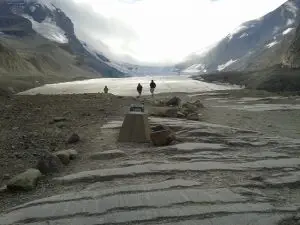In Defence of Climate Change Action
Authors: David Dougherty and Roger Gagne, Calgary

(recently exposed rock at the toe of the Athabasca Glacier)
Note: this article was first published in the Calgary Sun on June 3, 2016
Lorne Gunter is right in saying that Alberta’s climate leadership plan is convoluted.
After Ralph Klein timidly supporting the fed’s Voluntary Challenge, after empty promises from Ed Stelmach, Alison Redford, and Jim Prentice to cut emissions, improve our energy efficiency and develop our renewable resources, the NDP are now trying to work on many fronts, not by buying expensive ads in American newspapers, but with policies and action.
Talk is cheap, after all. Like Margaret Thatcher said, “Being powerful is like being a lady. If you have to tell people you are, you aren’t.”
In a speech at the 2nd World Climate Conference in November 1990, Thatcher, the Iron Lady with a BSc in chemistry, said, “The danger of global warming is as yet unseen, but real enough for us to make changes and sacrifices so that we do not live at the expense of future generations.”
It’s unseen no longer.
Hundreds of Albertans have lost homes and businesses in floods and fires in recent years, events which both climate scientists and the insurance industry warn will be more frequent in a warming world.
Military leaders, meanwhile, refer to climate change as a security threat; Admiral Samuel Locklear, Pacific commander for the U.S. Navy, passed over China and North Korea to call climate change the greatest threat to U.S. national security in the Pacific.
Every decade since the 1950s has seen higher average global temperatures than the one before. Now this decade is shaping up to be warmer again than the 2000s, by a wide margin.
We’ve noticed.
Mike Drew, a favourite columnist of many Sun readers, described one of his long country drives this spring and ended, “It felt like the end of a perfect August day. Too bad it was April.”
Gunter claims shutting down coal plants has done nothing for Ontario’s air quality.
The Ontario Ministry of the Environment, however, credits the coal phase-out, as well as the Drive Clean program which reduces harmful exhaust emissions from vehicles, for the fact they announced no smog alert days for Toronto in 2014. Hamilton saw 45 smog days in 2005, 31 in 2007, and 18 in 2012, when the coal phase-out was all but finished. In 2015? Zero smog days in Hamilton.
The sooner we begin addressing the air pollution problems in our major cities and downwind of fossil fuel installations, the better for our health.
While Gunter and others like to blame Ontario’s Green Energy Act for their high energy prices, in fact, much more came from cost overruns of nuclear power, upgrades of transmission and grid infrastructure, and a wee $1 billion gas plant scandal that drove Premier Dalton McGuinty out of office.
Gunter would prefer that we hitch our wagon to the dying coal industry. This spring he may not have noticed Arch Coal and Peabody Coal declaring bankruptcy, following 50 other coal bankruptcies since 2012, or China announcing a three-year moratorium on approvals of new coal plants. In January, India’s coal minister tweeted that solar is cheaper than coal power in some instances, and Vietnam’s prime minister announced his government will halt any new coal power development, focusing instead on renewables and efficiency.
Gunter scorns renewable power, yet rooftop solar produces power at the most expensive time of the day, shaving wholesale prices for everyone. It needs no expensive long-distance transmission, reducing load on the grid. Excess power can be stored in batteries, flywheels, pumped water, or even railway cars, for use at night or on very cloudy days.
Study after study over the years, by groups ranging from the Energy Trust of Oregon, to the American Society of Mechanical Engineers, to Alberta’s own Pembina Institute have shown that if we care about job creation, fossil fuels are not the best choice. They’re very capital-intensive and we get large plants, towers, and pipelines, but not many jobs.
In 2009, the U.S. Department of Commerce found that investing $1 million in oil and gas created 4.4 jobs, versus 7 to 8 for wind or solar power, and 17 jobs from improving energy efficiency in homes and buildings.
In a July 2008 interview, some two years after he’d left office, Klein said, “Never in my wildest dreams did I think that global warming would be such a hot issue.”
King Ralph belatedly saw that his government got caught flat-footed, yet promises by later Tory premiers didn’t translate into serious action. Now it’s the NDP’s turn at bat, and in the cheering section are not only energy CEOs together with Alberta doctors and mayors, but also a few well-known Conservatives. At a May 2015 panel hosted in Calgary by Canada’s EcoFiscal Commission, Alberta’s former treasurer, Jim Dinning said, “My electricity bill, and my home heating bill, should have a line item saying ‘Alberta’s Carbon Tax’ … Leadership is what’s needed. Politicians need steel in their spines to say ‘We’re going to help you change your behaviour’.”
It’s high time we get serious about protecting the Earth and each other using the best technology we have available.
Pricing carbon and building alternative energy can be a driver in Alberta’s new economy, bringing with it cleaner air and water, more jobs, international competitiveness, and a better shot at maintaining a stable climate for our children.
===============================================================================
Bio: David Dougherty and Roger Gagne are members of CCAN, the Calgary Climate Action Network
Leave a Reply